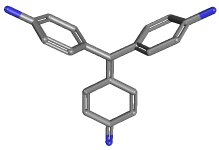|
PARAROSANILINE HCl |
| Synonyms. Pararosaniline hydrochloride; C.I. Basic Red 9; Basic Parafuchsin; Parafuchsin hydrochloride; Paramagenta hydrochloride; 4,4'-(4-Iminocyclohexa-2,5-dienylidenemethylene) dianiline hydrochloride; C.I. Basic Red 9 monohydrochloride; 4,4',4"-Triaminotriphenylmethane hydrochloride; 4,4'-((4-Imino-2,5-cyclohexadien-1-ylidene)methylene)dianiline monohydrochloride; 4,4'4''-Triaminotriphenylmethan-hydrochlorid; Basic parafuchsine; Basic Red 9; C.I. 42500; Fuchsine SP; Orient Para Magenta Base; p-Fuchsin; p-Rosaniline hydrochloride; Parafuchsin; Parafuchsine; Parafuksin; Paraosaniline hydrochloride; |
|
|
| PRODUCT IDENTIFICATION | |
|
CAS RN |
569-61-9 |
|
EINECS RN |
209-321-2 |
|
FORMULA |
C19H17N3·HCl |
|
MOLE WEIGHT |
323.82 |
|
H.S CODE |
3204.13.8000 |
|
SMILES |
C(\c1ccc(N)cc1)(c1ccc(N)cc1)=C1/C=CC(=N)C=C1.Cl |
|
CLASSIFICATION |
Coloring agent, Triarylmethane dye, Quaternary ammonium compound |
|
EXTRA NOTES |
Compounds that contain the triphenylmethane aniline structure found in rosaniline. Many of them have a characteristic magenta color and are used as coloring agents. |
|
|
| PHYSICAL AND CHEMICAL PROPERTIES | |
|
PHYSICAL STATE. |
dark green crystalline powder |
|
MELTING POINT |
268 ~ 270 C |
|
BOILING POINT |
|
|
DENSITY |
|
|
SOLUBILITY IN WATER |
10 g/l |
| SOLVENT SOLUBILITY |
65 g/l in ethanol |
|
VAPOR DENSITY |
|
|
log P(octanol-water) |
-0.21 |
|
VAPOR PRESSURE |
|
|
AUTOIGNITION TEMP |
|
| pK |
|
|
REFRACTIVE INDEX |
|
|
FLASH POINT |
|
|
|
| STABILITY AND REACTIVITY | |
| STABILITY | Stable under normal conditions. |
|
INCOMPATIBLE MATERIALS |
Strong oxidizing agents |
| POLYMERIZATION |
Has not been reported |
|
NFPA RATINGS |
Health: 1, Flammability: 0, Reactivity: 0 |
|
|
| EXTERNAL LINKS & GENERAL DESCRIPTION |
|
USA.gov - Pararosaniline hydrochloride Wikipedia Linking - Pararosaniline Google Scholar Search - Pararosaniline hydrochloride Drug Information Portal (U.S. National Library of Medicine) - Pararosaniline hydrochloride PubChem Compound Summary - Pararosaniline hydrochloride IPCS INCHEM - MAGENTA AND CI BASIC RED 9 http://www.ncbi.nlm.nih.gov/ - Pararosaniline hydrochloride Material Safety Data Sheet - Pararosaniline hydrochloride Hazardous Substances Data Bank - Pararosaniline hydrochloride EPA - Substance Registry Services - Pararosaniline hydrochloride |
|
|
| SALES SPECIFICATION | |
|
APPEARANCE |
dark green crystalline powder |
|
DYE CONTENT |
85% min |
|
ABSORPTION |
544 nm (in 50% ethanol) λ max |
|
|
| TRANSPORT & REGULATORY INFORMATION | |
|
UN NO. |
|
| HAZARD CLASS |
|
| PACKING GROUP | |
|
|
| SAFETY INFORMATION | |
|
HAZARD OVERVIEW |
OSHA Hazards:Carcinogen, Target Organ Effect (Liver, Thyroid, Skin, Bladder, Pituitary). May cause cancer. Eyes: May cause eye irritation. Skin: May be harmful if absorbed through skin. May cause skin irritation. Inhalation: May be harmful if inhaled. May cause respiratory tract irritation. Ingestion: May be harmful if swallowed. |
| SIGNAL WORD | Danger |
|
PICTOGRAMS |
|
|
HAZARD STATEMENTS |
h303-H350 |
|
P STATEMENTS |
P201-P308 + P313 |
| EC DIRECTIVES |
|
| HAZARD CODES |
|
|
RISK PHRASES |
45 |
|
SAFETY PHRASES |
45-53 |
|
|
| PACKING |
|
Preserve in light-resistant and well-closed containers |
|
|

